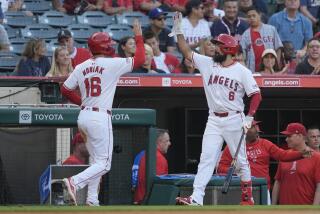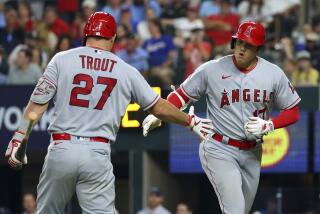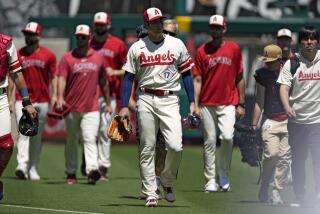Safety on the basepaths? Angels will let it slide
Reporting from Tempe, Ariz. — Sliding headfirst into bases is like chewing smokeless tobacco for major league baseball players. They know it’s risky, yet many of them still do it.
News of the serious neck injury sustained by Arizona State outfielder Cory Hahn when he dived into second during a game Sunday rattled clubhouses around the Cactus League, but not enough for players to give up the practice.
“You can watch 1,000 games and never see it, but once it happens once it opens your eyes,” Angels second baseman Howie Kendrick said. “You think, ‘Man, that could have happened to me.’
“But it’s one of those things you feel comfortable doing one way, and you don’t think about doing it at the time. My natural reaction is to lunge forward and dive into a bag. It’s something I’ve always done. When you’re playing, you go on instinct.”
Kendrick always goes feet first when he’s breaking up a double play, but he usually goes headfirst on stolen-base attempts. So does Reggie Willits.
“I know it’s more dangerous, but I’ll probably still do it,” Willits said. “Even if you take the neck thing out of it, there’s a greater chance of injuring a finger or shoulder. I try not to use it unless it’s going to be a bang-bang play.”
Hahn is a freshman from Santa Ana Mater Dei High, and he was The Times’ player of the year in Southern California last season. He was injured when his head collided with the knee of New Mexico second baseman Kyle Stiner. Hahn was taken off the field on a stretcher and transported by ambulance to a hospital, where he had surgery.
As jarring as the injury was, the Angels won’t issue any directives for players to go feet-first. Minnesota slugger Justin Morneau suffered a concussion last July when his head hit the knee of Toronto second baseman John McDonald — on a feet-first slide.
“It’s crazy — a kid gets hurt diving head-first and a guy gets hurt going feet-first,” Angels third base coach Dino Ebel said. “You want to avoid it, but if a guy’s comfortable doing it, you don’t want to take it away because maybe he’s a bad slider. It’s tough to get it out of them because it’s instinct; they’ve done it their whole lives.”
Place your order
Manager Mike Scioscia said he is leaning toward a batting order of Maicer Izturis, Bobby Abreu, Torii Hunter, Kendry Morales, Vernon Wells, Kendrick, Erick Aybar, Jeff Mathis and Peter Bourjos.
Scioscia likes sandwiching Hunter and Wells, who bat right-handed, around Morales, a switch-hitter. Hunter’s speed and ability to go from first to third on singles gives him the edge over Wells in the No. 3 spot.
There is a concern the lineup could drop off considerably after Aybar — Mathis hit .195 last season and Bourjos, called up from triple A in early August, hit .204.
“There needs to be production at the bottom,” Scioscia said. “If you’re only pressuring teams once every third inning, you’re not going to get it done.
“Though Peter’s average didn’t look like he was creating a lot he showed surprising power [six home runs, four triples, six doubles in 181 at-bats], so we’re looking forward to seeing how that goes.”
More to Read
Go beyond the scoreboard
Get the latest on L.A.'s teams in the daily Sports Report newsletter.
You may occasionally receive promotional content from the Los Angeles Times.











